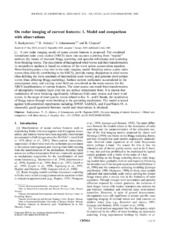On radar imaging of current features: 1. Model and comparison with observations
Journal article, Peer reviewed
Published version
Permanent lenke
https://hdl.handle.net/1956/753Utgivelsesdato
2005-07-22Metadata
Vis full innførselSamlinger
- Geophysical Institute [1198]
Originalversjon
https://doi.org/10.1029/2004jc002505Sammendrag
A new radar imaging model of ocean current features is proposed. The simulated normalized radar cross section (NRCS) takes into account scattering from ‘‘regular’’ surfaces (by means of resonant Bragg scattering and specular reflections) and scattering from breaking waves. The description of background wind waves and their transformation in nonuniform medium is based on solution of the wave action conservation equation. Wave breaking plays a key role in the radar imaging model. Breaking waves scatter radio waves (thus directly contributing to the NRCS), provide energy dissipation in wind waves (thus defining the wave spectrum of intermediate scale waves), and generate short surface waves (thus affecting Bragg scattering). Surface current, surfactants accumulated in the convergence zone, and varying wind field are considered as the main sources for the NRCS manifestations of current features. The latter source can result from transformation of atmospheric boundary layer over the sea surface temperature front. It is shown that modulation of wave breaking significantly influences both radar returns and short wind waves. In the range of short gravity waves related to Ku- X-, and C-bands, the modulation of Bragg waves through wave breaking is the governing mechanism. The model is tested against well-controlled experiments including JOWIP, SARSEX, and CoastWatch-95. A reasonably good agreement between model and observations is obtained.
